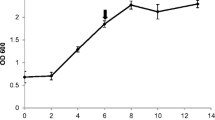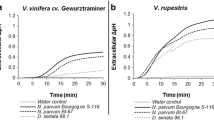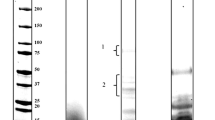Abstract
Cell suspension cultures of Vitis vinifera cv. Vinhão (Vv) were used to study the putative response of V. vinifera to Phaeomoniella chlamydospora (Pc), a fungus frequently associated with esca and grapevine decline. Cells were elicited with a Pc autoclaved biomass extract and methyl jasmonate (MeJ). Phenolic production was evaluated by HPLC-DAD and HPLC-MS/MS. Phenolic production of Vv cells significantly changes after elicitation. Compared to control, Vv cells elicited by Pc extract increase their stilbene production 20-fold and those elicited by MeJ increase stilbenic production 9-fold. In both cases, there is de novo production of viniferin type compounds. We also analyzed the oxidative burst of Vv cells after elicitation with Pc extract and MeJ, using the probe 2′,7′-dichlorodihydrofluorescein diacetate. Adding Pc extract induces an oxidative burst that shows a biphasic pattern in Vv cells. Moreover, the induction of 7 defence-related genes expression in Vv cell cultures upon Pc extract elicitation was investigated employing semi-quantitative RT-PCR. Elicitation increases the expression of class 6 and class 10 pathogenesis-related proteins, β-1,3-glucanase, class III chitinase, lipoxygenase, phenylalanine ammonia lyase and stilbene synthase. Therefore, Vv in vitro cell cultures could be an important tool to study esca disease, since they offer a simple, rapid and selective way to evaluate plant/fungus interactions.




Similar content being viewed by others
References
Adrian, M., Jeandet, P., Douillet-Breuil, A.-C., Tesson, L., & Bessis, R. (2000). Stilbene content of mature Vitis vinifera berries in response to UV-C elicitation. Journal of Agricultural and Food Chemistry, 48, 6103–6105.
Agrelli, D., Amalfitano, C., Conte, P., & Mugnai, L. (2009). Chemical and spectroscopic characteristics of the wood of Vitis vinifera Cv. sangiovese affected by esca disease. Journal of Agricultural and Food Chemistry, 57, 11469–11475.
Amalfitano, C., Evidente, A., Surico, G., Tegli, S., Bertelli, E., & Mugnai, L. (2000). Phenols and stilbene polyphenols in the wood of esca-diseased grapevines. Phytopathologia Mediterranea, 39, 178–183.
Aziz, A., Poinssot, B., Daire, X., Adrian, M., Bézier, A., Lambert, B., et al. (2003). Laminarin elicits defense responses in grapevine and induces protection against Botrytis cinerea and Plasmopara viticola. Molecular Plant-Microbe Interactions, 16, 1118–1128.
Bavaresco, L., Petegolli, D., Cantu, E., Fregoni, M., Chiusa, G., & Trevisan, M. (1997). Elicitation and accumulation of stilbene phytoalexin in grapevine berries infected by Botrytis cinerea. Vitis, 36, 77–83.
Belhadj, A., Saigne, C., Telef, N., Cluzet, S., Bouscaut, J., Corio-Costet, M.-F., et al. (2006). Methyl jasmonate induced defense responses in grapevine and triggers protection against Erysiphe necator. Journal of Agricultural and Food Chemistry, 54, 9119–9125.
Bézier, A., Lambert, B., & Baillieul, F. (2002). Study of defense-related gene expression in grapevine leaves and berries infected with Botrytis cinerea. European Journal of Plant Pathology, 108, 111–120.
Bonomelli, A., Mercier, L., Franchel, J., Baillieul, F., Benizri, E., & Mauro, M.-C. (2004). Response of grapevine defenses to UV-C exposure. American Journal of Enology and Viticulture, 55, 51–59.
Borie, B., Jeandet, P., Parize, A., Bessis, R., & Adrian, M. (2004). Resveratrol and stilbene synthase mRNA production in grapevine leaves treated with biotic and abiotic phytoalexin elicitors. American Journal of Enology and Viticulture, 55, 60–64.
Bruno, G., & Sparapano, L. (2006a). Effects of three-esca associated fungi on Vitis vinifera L.: I. Characterization of secondary metabolites in culture media and host responses to the pathogens in calli. Physiological and Molecular Plant Pathology, 69, 209–223.
Bruno, G., & Sparapano, L. (2006b). Effects of three esca-associated fungi on Vitis vinifera L.: II. Characterization of biomolecules in xylem sap and leaves of healthy and diseased vines. Physiological and Molecular Plant Pathology, 69, 195–208.
Bruno, G., Sparapano, L., & Graniti, A. (2007). Effects of three esca-associated fungi on Vitis vinifera L.: IV. Diffusion through the xylem of metabolites produced by two tracheiphilous fungi in the woody tissue of grapevine leads to esca-like symptoms on leaves and berries. Physiological and Molecular Plant Pathology, 71, 106–124.
Busam, G., Kassemeyer, H.-H., & Matern, U. (1997). Differential expression of chitinases in Vitis vinifera L. responding to systemic acquired resistance activators or fungal challenge. Plant Physiology, 115, 1029–1038.
Chiarappa, L. (2000). Esca (black measles) of grapevine. An overview. Phytopathologia Mediterranea, 39, 11–15.
Chicau, G., Aboim-Inglez, M., Cabral, S., & Cabral, J. (2000). Phaeoacremonium chlamydosporum and Phaeoacremonium angustius associated with esca and grapevine decline in Vinho Verde grapevines in northwest Portugal. Phytopathologia Mediterranea, 39, 80–86.
Creelman, R., & Mullet, J. (1997). Oligosaccharins, brassinolides, and jasmonates: nontraditional regulators of plant growth, development and gene expression. The Plant Cell, 9, 1211–1223.
Dai, G., Andary, C., Mondolot-Cosson, L., & Boubals, D. (1995). Histochemical studies on the interaction between three species of grapevine, Vitis vinifera, V. rupestris and V. rotundifolia and the downy mildew fungus, Plasmopara viticola. Phisiological and Molecular Plant Pathology, 46, 177–188.
Del Rio, J., Gonzalez, A., Fuster, M., Botia, J., Gomez, P., Frias, V., et al. (2001). Tylose formation and changes in phenolic compounds of grape roots infected with Phaeomoniella chlamydospora and Phaeoacremonium species. Phytopathologia Mediterranea, 40, S394–S399.
Di Marco, S., Mazzullo, A., Calzarano, F., & Cesari, A. (2000). The controlo f esca: status and perspectives. Phytopathologia Mediterranea, 39, 232–240.
Douillet-Breuil, A.-C., Jeandet, P., Adrian, M., & Bessis, R. (1999). Changes in the phytoalexin content of various Vitis spp. in response to ultraviolet C elicitation. Journal of Agricultural and Food Chemistry, 47, 4456–4461.
Feliciano, A., Eskalen, A., & Gubler, W. (2004). Differential susceptibility of three grapevine cultivars to Phaeoacremonium aleophilum and Phaeomoniella chlamydospora in California. Phytopathologia Mediterranea, 43, 66–69.
Fung, R., Gonzalo, M., Fekete, C., Kovacs, L., He, Y., Marsh, E., et al. (2008). Powdery mildew induces defense-oriented reprogramming of the transcriptome in a susceptible but not in a resistant grapevine. Plant Physiology, 146, 236–249.
Fussler, L., Kobes, N., Bertrand, F., Maumy, M., Grosman, J., & Savary, S. (2008). A characterization of grapevine trunk diseases in France from data generated by the national grapevine wood diseases survey. Phytopathology, 98, 571–579.
Goetz, G., Fkyerat, A., Métais, N., Kunz, M., Tabacchi, R., Pezet, R., et al. (1999). Resistance factors to grey mould in grape berries: identification of some phenolics inhibitors of Botrytis cinerea stilbene oxidase. Phytochemistry, 52, 759–767.
Graniti, A., Surico, G., & Mugnai, L. (2000). Esca of grapevine: a disease complex or a complex of diseases? Phytopathologia Mediterranea, 39, 16–20.
Gubler, W., Thind, T., Feliciano, A., & Eskalen, A. (2004). Pathogenicity of Phaeoacremonium aleophilum and Phaeomoniella chlamydospora on grape berries in California. Phytopathologia Mediterranea, 43, 70–74.
Gundlach, H., Müller, M., Kutchan, T., & Zenk, M. (1992). Jasmonic acid is a signal transducer in elicitor-induced plant cell cultures. Proceedings of the National Academy of Sciences USA, 89, 2389–2393.
Jacobs, A., Dry, I., & Robinson, S. (1999). Induction of different pathogenesis-related cDNAs in grapevine infected with powdery mildew and treated with ethephon. Plant Pathology, 48, 325–336.
Jeandet, P., Bessis, R., Sbagghi, M., & Meunier, P. (1995). Production of the phytoalexin resveratrol by grapes as a response to Botrytis attack under natural conditions. Journal of Phytopathology, 143, 135–139.
Jeandet, P., Douillet-Breuil, A.-C., Bessis, R., Debord, S., Sbaghi, M., & Adrian, M. (2002). Phytoalexins from the Vitaceae: biosynthesis, phytoalexin gene expression in transgenic plants, antifungal activity and metabolism. Journal of Agricultural and Food Chemistry, 50, 2731–2741.
Kortekamp, A. (2006). Expression analysis of defence-related genes in grapevine leaves after inoculation with a host and a non-host pathogen. Plant Physiology and Biochemistry, 44, 58–67.
Krisa, S., Larronde, F., Budzinsky, H., Decendit, A., Deffieux, G., & Mérillon, J.-M. (1999). Stilbene production by Vitis vinifera cell suspension cultures: methyl jasmonate induction and 13 C biolabeling. Journal of Natural Products, 62, 1688–1690.
Lamb, C., & Dixon, R. (1997). The oxidative burst in plant disease resistance. Annual Reviews of Plant Physiology and Plant Molecular Biology, 48, 251–275.
Langcake, P. (1981). Disease resistance of Vitis spp. and the production of stress metabolites resveratrol, ε-viniferin, α-viniferin and pterostilbene. Physiological Plant Pathology, 18, 213–226.
Langcake, P., & Pryce, R. (1977). The production of resveratrol and the viniferins by grapevines in response to ultraviolet irradiation. Phytochemistry, 16, 1193–1196.
Larignon, P., & Dubos, B. (1997). Fungi associated with esca disease in grapevine. European Journal of Plant Pathology, 103, 147–157.
Letousey, P., Baillieul, F., Perrot, G., Rabenoelina, F., Boulay, M., Vaillant-Gaveau, N., et al. (2010). Early events prior to visual symptoms in the apoplectic form of grapevine esca disease. Phytopathology, 100, 424–431.
Lima, M., Felgueiras, M., Graça, G., Rodrigues, J., Barros, A., Gil, A., et al. (2010). NMR metabolomics of esca disease-affected Vitis vinifera cv. Alvarinho leaves. Journal of Experimental Botany, 61, 4033–4042.
Marchi, G., Peduto, F., Mugnai, L., Di Marco, S., Calzarano, F., & Surico, G. (2006). Some observations on the relationship of manifest and hidden esca to rainfall. Phytopathologia Mediterranea, 45, S117–S126.
Martin, N., Vesentini, D., Rego, C., Monteiro, S., Oliveira, H., & Ferreira, R. (2009). Phaeomoniella chlamydospora infection induces changes in phenolic compounds content in Vitis vinifera. Phytopathologia Mediterranea, 48, 101–116.
Melchior, F., & Kindl, H. (1991). Coordinate- and elicitor-dependent expression of stilbene synthase and phenylalanine ammonia-lyase genes in Vitis cv. Optima. Archives of Biochemistry and Biophysics, 288, 552–557.
Mugnai, L., Surico, G., & Esposito, A. (1996). Microflora associata al mal dellésca della vite in Toscana. Informatore Fitopatologico, 11, 49–55.
Mugnai, L., Graniti, A., & Surico, G. (1999). Esca (black measles) and brown wood-streaking: two old and elusive diseases of grapevines. Plant Disease, 83, 404–418.
Parsons, H., Yip, J., & Vanlerberghe, G. (1999). Increased respiratory restriction during phosphate-limited growth in transgenic tobacco cells lacking alternative oxidase. Plant Physiology, 121, 1309–1320.
Repka, V. (2006). Early defence responses induced by two distinct elicitors derived from a Botrytis cinerea in grapevine leaves and cell suspensions. Biologia Plantarum, 50, 94–106.
Repka, V., Fischerová, I., & Silhárová, K. (2001). Methyl jasmonate induces a hypersensitive-like response of grapevine in the absence of avirulent pathogens. Vitis, 40, 5–10.
Robert, N., Ferran, J., Breda, C., Coutos-Thévenot, P., Boulay, M., Buffard, D., et al. (2001). Molecular characterization of the incompatible interaction of Vitis vinifera leaves with Pseudomonas syringae pv. pisi: expression of genes coding for stilbene synthase and class 10 PR protein. European Journal of Plant Pathology, 107, 249–261.
Robert, N., Roche, K., Lebeau, Y., Breda, C., Boulay, M., Esnault, R., et al. (2002). Expression of grapevine chitinase genes in berries and leaves infected by fungal or bacterial pathogen. Plant Science, 162, 389–400.
Santos, C., Fragoeiro, S., & Phillips, A. (2005). Physiological response of grapevine cultivars and a rootstock to infection with Phaeoacremonium and Phaeomoniella isolates: an in vitro approach using plants and calluses. Scientia Horticulturae, 103, 187–198.
Sarig, P., Zutkhi, Y., Monjauze, A., Lisker, N., & Ben-Arie, R. (1997). Phytoalexin elicitation in grape berries and their susceptibility to Rhizopus stolonifer. Physiological and Molecular Plant Pathology, 50, 337–347.
Silva, B., Ferreres, F., Malva, J., & Dias, A. (2005). Phytochemical and antioxidant characterization of Hypericum perforatum alcoholic extracts. Food Chemistry, 90, 157–167.
Smalley, E., & Guries, R. (1993). Breeding elms for resistance to Dutch elm diseases. Annual Review of Phytopathology, 31, 325–352.
Sparapano, L., Bruno, G., & Graniti, A. (2001a). Three-year observation of grapevines cross-inoculated with esca-associated fungi. Phytopathologia Mediterranea, 40, S376–S386.
Sparapano, L., De Leonardis, S., Campanella, A., & Bruno, G. (2001b). Interaction between esca-associated fungi, grapevine calli and micropropagated shoot cultures of grapevine. Phytopathologia Mediterranea, 40, S423–S428.
Surico, G., Mugnai, L., & Marchi, G. (2006). Older and more recent observations on esca: a critical overview. Phytopathologia Mediterranea, 45, S68–S86.
Tabacchi, R., Fkyerat, A., Poliart, C., & Dubin, G.-M. (2000). Phytotoxins from fungi of esca of grapevine. Phytopathologia Mediterranea, 39, 156–161.
Wang, H., & Joseph, J. (1999). Quantifying cellular oxidative stress by dichlorofluorescein assay using microplate reader. Free Radical Biology & Medicine, 27, 612–616.
Wiese, W., Vornam, B., Krause, E., & Kindl, H. (1994). Structural organization and differential expression of three stilbene synthase genes located on a 13 Kb grapevine DNA fragment. Plant Molecular Biology, 26, 667–677.
Wojtaszek, P. (1997). Oxidative burst: an early plant response to pathogen infection. Biochemical Journal, 322, 681–692.
Acknowledgements
Marta Lima was supported by Fundação para a Ciência e a Tecnologia (FCT) through the PhD grant SFRH/BD/17944/2004.
Author information
Authors and Affiliations
Corresponding author
Rights and permissions
About this article
Cite this article
Lima, M.R.M., Ferreres, F. & Dias, A.C.P. Response of Vitis vinifera cell cultures to Phaeomoniella chlamydospora: changes in phenolic production, oxidative state and expression of defence-related genes. Eur J Plant Pathol 132, 133–146 (2012). https://doi.org/10.1007/s10658-011-9857-4
Accepted:
Published:
Issue Date:
DOI: https://doi.org/10.1007/s10658-011-9857-4




